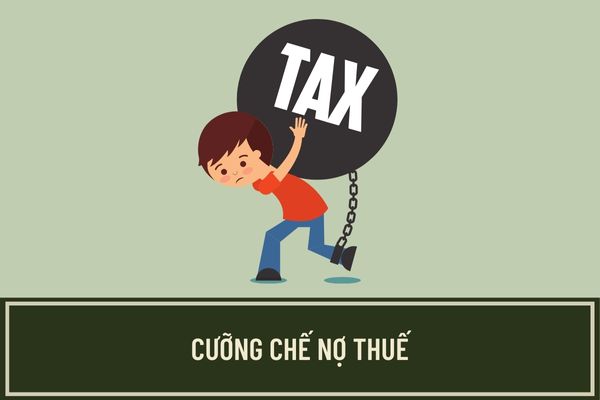Process of Enforcing Tax Debt by Deducting Money from Accounts, Requesting Account Freezing: Implementation Procedures
Tax Debt Enforcement Procedure by Account Deduction and Account Freeze Request
According to Subsection 1, Section II, Part B of the Tax Debt Enforcement Procedure issued together with Decision 1795/QD-TCT Year 2022, the procedure for enforcing tax debt by account deduction and account freeze request is carried out through the following steps:
Step 1: Prepare a list of taxpayers subject to enforcement.
Step 2: Collect and verify information of taxpayers subject to enforcement.
Step 3: Prepare a list of taxpayers to be enforced.
Step 4: Issue the enforcement decision.
Step 5: Send and publicize the enforcement decision.
Step 6: Execute the enforcement action.

How is the procedure for enforcing tax debt by account deduction and account freeze request carried out?
How is the collection and verification of taxpayer information conducted in the account deduction and account freeze request enforcement procedure?
Based on Subsection 1.2, Section II, Part B of the Tax Debt Enforcement Procedure issued together with Decision 1795/QD-TCT Year 2022, the collection and verification of information of taxpayers subject to enforcement is determined as follows:
(1) Based on the list of taxpayers (NNT) subject to enforcement (form No. 01-1/DS-TK), the official reviews the information about the accounts of NNT for enforcement preparation:
- If the tax authority has sufficient information about one or several accounts of NNT opened at the State Treasury (KBNN), Commercial Banks (NHTM), or other credit institutions, then the NNT is transferred to the list of those subject to account deduction enforcement, account freeze (form No. 01-2/DS-TK issued together with this procedure).
- If NNT is an enterprise or organization and the tax authority's database does not have information about NNT’s accounts or the account information is inaccurate, the official drafts and reports to the department/team leader to submit to the Head of the tax authority or the deputy assigned to manage debt and enforcement tasks to issue a document requesting NNT, KBNN, NHTM, or other credit institutions to provide information.
- For individual taxpayers: The tax authority may verify the account information of NNT if deemed necessary.
(2) The information to be collected and verified:
- Accounts opened at KBNN, NHTM, other credit institutions: place of opening, account numbers;
- Account balances, other information related to the accounts and transactions through the accounts (if necessary).
- No later than the next working day, the official must update the information into the list of NNT subject to enforcement (form No. 01-1/DS-TK).
If the bank account information collected is not yet updated in the tax management application, the enforcement unit transfers the information to the functional unit for updating in the tax management application.
In what form is the tax debt enforcement decision by account deduction and account freeze request sent to NNT?
According to Point 1.5, Subsection 1, Section II, Part B of the Tax Debt Enforcement Procedure issued together with Decision 1795/QD-TCT Year 2022, the issuance and sending of the enforcement decision by account deduction and account freeze request are conducted as follows:
- The tax debt enforcement decision along with the State Budget Collection Order is sent to the enforced NNT, KBNN, NHTM, other credit institutions where the enforced NNT opens accounts on the same day the enforcement decision is issued.
The sending form is carried out according to the provisions at Point c, Clause 3, Article 31 of Decree 126/2020/ND-CP. Specifically as follows:
Enforcement by account deduction, account freeze of the taxpayer under the administrative enforcement decision on tax management
...
3. The enforcement decision of account deduction, account freeze
...
c) The enforcement decision by account deduction, account freeze is sent to the taxpayer being enforced, the state treasury, credit institutions where the taxpayer opens accounts, and other related organizations, individuals along with the State Budget Collection Order on the same day the enforcement decision is issued and is updated on the tax or customs sector’s electronic information page.
c.1) The enforcement decision is sent electronically in case of electronic transaction conditions in tax management, or by certified mail via post or delivered directly if electronic transaction conditions are not met.
c.2) If the decision is delivered directly and the organization or individual being enforced does not receive it, the competent person or tax official, customs official responsible for delivering the enforcement decision shall make a record of the organization or individual refusing to receive the decision, confirmed by the local government where the organization or individual is registered with the tax authority, and it is considered delivered.
c.3) If sent by certified mail and after 10 days from the first delivery attempt, if the enforcement decision is returned due to non-receipt by the organization or individual being enforced, and the decision has been posted at the office of the organization or the residential place of the individual being enforced, or there is a reason to believe that the taxpayer being enforced is evading receipt of the decision, it is considered delivered.
Simultaneously, the tax authority is responsible for posting information about the taxpayer being enforced on the tax sector’s electronic information page as follows:
+ If the enforcement decision is signed electronically, the tax management application system will automatically publicize the information according to form No. 01/CKCC issued together with this procedure.
+ If the enforcement decision is not signed electronically, the official enters the information in the enforcement decision system for public disclosure.
LawNet